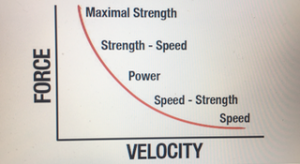Within the game of baseball, both Strength and Power play important roles in determining success, both at the plate and in the field of play. They often cross over one another within an athletic performance training program, yet have separate characteristics that define one another.
This article will help distinguish one from the other.
First of all, Power maybe defined as the ability to generate as much force as possible, and with the proper technique or form. It cannot be performed too slowly. The load (or resistance) must be heavy, but not to the point where the exercise (or movement) is compromised.
You must be able to repeat the exercise/movement more than once in a short time frame, effectively. It is lower resistance and higher, faster, more explosive repetitions. Power is going up to the plate and hitting the ball out of the park.
Power = Strength x Speed
Examples:
- Swinging a baseball bat
- A 2nd baseman diving one way to catch a line drive
- Jumping up onto a box/platform
- Throwing a medium weighted medicine ball
- Track & field (javelin or discus throw)
Strength, on the other hand, is defined as the amount of force a muscle, or group of muscles, can exert against an external load. The tempo is slow, the load/resistance is heavy, repetitions are low, requires 80 percent or greater of an athlete’s one repetition maximum (1-5 repetitions) and needs more rest between sets (3 minutes or more).
Strength in baseball doesn’t mean you have develop big muscles, like in bodybuilding, for example. Strength is required in baseball to help your body survive a long season without breaking down (pulled or strained muscles), due to all of the continuous overuse certain muscles receive on a daily basis (example: rotator cuff from throwing, hamstrings from base running, abdominals/obliques from batting, etc).
Examples:
- Weightlifting/powerlifting competitions (not for baseball players)
- Squats
- Bench presses
- Deadlifts
- Body weight plank holds (core exercise)
- Body weight single leg squats (weighted vest resistance)
Also, see the Force-Velocity Curve:
Here are three exercises that will demonstrate both Power and Strength:
- Sample Exercise 1: Front Squat – Strength
- Sample Exercise 2: Box Jumps – Power
- Sample Exercise 3: Medicine Ball Squat Tosses – Power
To be a successful baseball player, both Power and Strength must be implemented into a strength and conditioning program. The game requires both. Injuries will be prevented, balls will be hit, runs will be scored, and careers will be defined. Know the difference and see what happens.
For more information, visit www.diamonddirectors.com today. Also, check out our Digital Magazine, Changing the Game.
___________________________________________________________________________
Roger A. Scott, MS, CSCS, RSCC, is a former strength & conditioning coach for the Cincinnati Reds, New York Mets and Chicago White Sox organizations. He currently is a Kineti-Flex coach for Flexogenix (Corrective Exercise/Strength & Conditioning Specialist) in Atlanta, and available for private consulting and training for both athletes and non-athletes. Roger has also been a frequent volunteer strength & conditioning coach for L.E.A.D. in Downtown Atlanta. He can be reached at roger.scott2626@gmail.com or at 404-803-0222.


Leave a Reply